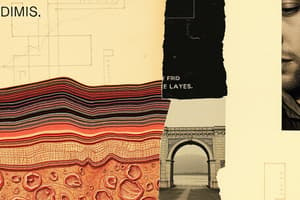Podcast
Questions and Answers
Which of the following describes a lesion that has a flat area of altered color, typically less than 1 cm in diameter?
Which of the following describes a lesion that has a flat area of altered color, typically less than 1 cm in diameter?
- Macule (correct)
- Plaque
- Papule
- Nodule
What is the term for lesions that merge together, losing their individual characteristics?
What is the term for lesions that merge together, losing their individual characteristics?
- Confluent (correct)
- Discrete
- Target
- Annular
Which type of skin condition is characterized by areas of skin that are paler than the surrounding skin?
Which type of skin condition is characterized by areas of skin that are paler than the surrounding skin?
- Hypo-pigmentation (correct)
- Hyper-pigmentation
- De-pigmentation
- Erythema
Identify the term used for raised lesions that are larger than 0.5 cm and have a deeper component.
Identify the term used for raised lesions that are larger than 0.5 cm and have a deeper component.
What type of dermatological lesion is characterized by concentric rings resembling a dartboard?
What type of dermatological lesion is characterized by concentric rings resembling a dartboard?
What does dermatology study?
What does dermatology study?
Why is the study of dermatology considered important?
Why is the study of dermatology considered important?
Which of the following best describes a comedone?
Which of the following best describes a comedone?
What is a common characteristic of open comedones?
What is a common characteristic of open comedones?
What does the term 'generalized' refer to in dermatology?
What does the term 'generalized' refer to in dermatology?
How can dermatology assist individuals?
How can dermatology assist individuals?
Which term refers to an area of altered skin?
Which term refers to an area of altered skin?
Which of the following defines 'pruritus' in dermatology?
Which of the following defines 'pruritus' in dermatology?
Study Notes
Introduction to Dermatology
- Dermatology is the study of normal and abnormal skin, hair, nails, and mucous membranes.
- It is crucial due to the skin being the largest organ of the human body.
- Skin diseases affect up to a third of the population at any given time, leading to significant physical and mental impact.
Importance of Dermatology
- Skin conditions can cause physical damage, mental distress, and restrictions in daily life, socially and occupationally.
- Dermatology provides essential care for conditions such as acne, skin cancer screening, eczema, and psoriasis.
Basic Terms in Dermatology
- Pruritus: Refers to itching.
- Lesion: An area of altered skin.
- Rash: An eruption on the skin.
- Naevus: A localized malformation of tissue, such as a mole.
Comedones
- Small bumps found at the opening of skin pores, which can be flesh-colored, white, or dark, affecting skin texture.
- Open comedones: Known as blackheads (surface disrupted).
- Closed comedones: Known as whiteheads (surface intact).
Distribution Patterns of Lesions
- Generalized: Lesions spread all over the body.
- Widespread: Extensive lesion coverage.
- Localized: Lesions restricted to one skin area.
- Defined patterns such as flexural (body folds), extensor (knees, elbows), pressure areas (sacrum, buttocks), dermatome (skin supplied by a single spinal nerve), and photosensitive (sun-exposed areas).
Shape and Pattern of Lesions
- Discrete: Individual lesions are separate.
- Confluent: Merging lesions.
- Linear: Lesions arranged in a line.
- Target: Lesions with concentric rings.
- Annular: Circular or ring-shaped lesions.
- Discoid: Coin-shaped round lesions.
Color Changes in Skin
- Erythema: Redness due to inflammation, blanches under pressure.
- Hypo-pigmentation: Lighter areas of skin (e.g., due to superficial fungal infections).
- De-pigmentation: Absence of melanin resulting in white skin (e.g., Vitiligo).
- Hyper-pigmentation: Darker skin areas, can be caused by post-inflammatory processes, melasma, or naevi.
Structure of Lesions
- Macule: Flat area of altered color (e.g., freckles).
- Patch: Larger flat area with altered color or texture.
- Papule: Solid raised lesion smaller than 0.5 cm in diameter (e.g., xanthomata).
- Nodule: Solid raised lesion larger than 0.5 cm with deeper components.
- Plaque: Palpable, scaling raised lesion larger than 0.5 cm.
- Pustule: Lesion containing pus.
Studying That Suits You
Use AI to generate personalized quizzes and flashcards to suit your learning preferences.
Related Documents
Description
This quiz focuses on the fundamentals of dermatology, covering definitions and the significance of the field. Students will learn to identify basic terms used in dermatology and understand the importance of skin health. Perfect for those beginning their journey in dermatological studies.




